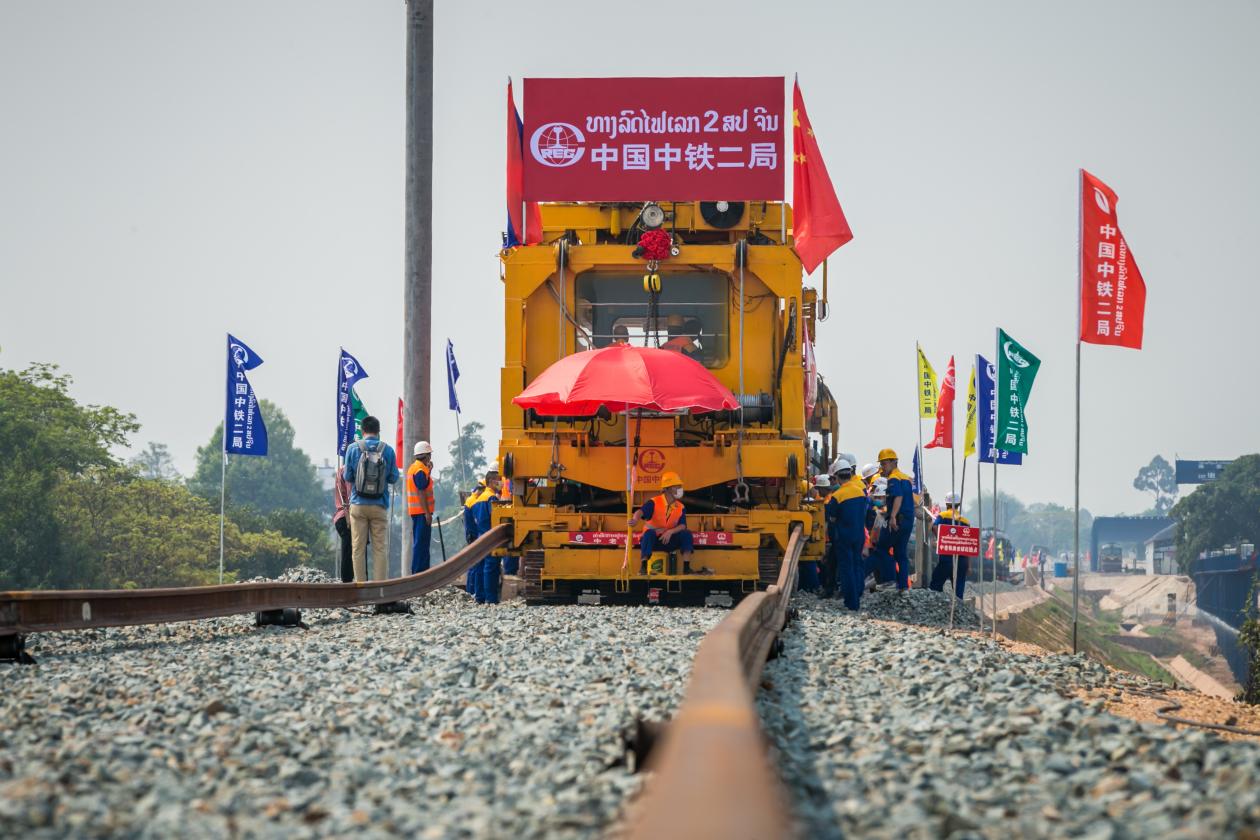

Written By Guan Qiuyun / Translated By Qu Wenyuan
In Chinese President Xi Jinping’s letter to all students and faculty of China-Laos Nongping Village Primary School in 2019, it reads, “I hope you can come to Beijing via the China-Laos Railway soon”. 2 years later, at the 60th anniversary of the establishment of China-Laos Diplomatic Relations, the dream of going to Beijing is closer as the China-Laos Railway will be completed by the end of this year.
This railway of good wishes connects multiple places between the two countries. Both construction workers and people along the route have experienced the changes and opportunities.
The dream life has come
In a China-Laos Railway work conference held not long ago, the 34-year-old Songcha Saiyaphone was awarded the title of Railway Craftsman of the Year. This Lao worker, responsible for tunnel construction in the technology section of the project, was one of the first students of the Lao staff training school.
“I took the training very seriously, I obtained more knowledge and learned to use more advanced equipment after I came to the project.” Songcha said, “(China’s) railway system is more complex with higher technical skills required. The projects are more diversified. ”
With improved skills and more work experience, Songcha has dreamed bigger. “Railway development in Laos has just started. In the future, railway can be extended to all parts of the country”, Songcha said, “Perhaps when I have more experience and better skills, I will start my own surveying and mapping business, and work with the Chinese companies.”
Kanpiuo Dawa was another Craftsman of the Year. He is 36 years old and comes from Xieng Ngeun District of Luang Prabang, a mountainous region in Laos. He has 4 kids. He used to make a living by farming, collecting firewood and hunting, however, he could hardly make ends meet.
5 years ago, he heard that the Chinese were building railways here and hiring people. He felt that this was a life changing opportunity. After the interview, he got an offer as a welder at a steel structure plant of Sinohydro Bureau No. 3 Co., Ltd.
“I learned welding before. But this is different from before. All tools are modern, and the Chinese teachers teach me all they can offer.” He worked hard and was promoted to the chief of the foreign welder team. “When I worked as a farmer, we had to live on a tight budget. Now my wage is 5 to 6 times of that of the past and the working environment is much better. I have built a new house and can afford the tuition fees of the children.” Kanpiuo said.
In the Jingzhai Tunnel, the first batch of Lao students are taking training on site. Songpon is one of them. Once the railway is in service, she will be one of the first train drivers of the China-Laos railway.

“Male is dominating the railway industry. But I think women can do whatever men can. ” So I want to be the first female driver in this railway, making my dream of coming out of village come true.” She said. China-Laos Railway is the first modern railway in Laos, for which the first trained drivers will be the pioneers for the railway development in Laos, in particular in cultivating railway professionals.
As a Chinese saying goes, “with the whistle of the train comes tons of gold”. It indicates the enormous opportunities train service brings. Since the launch of this project, 110,000 new jobs were created. Local people got more job and training opportunities and thus local economy was boosted. Thanks to the China-Laos Railway project, the Lao people’s quality of life is now improving, and they are getting closer to their dream life.
New opportunities brought by the railway
The latest report of the World Bank shows that in the long term, the China-Laos Railway can help increase Lao’s income by 21%. By 2030, the transit trade volume of this railway route is expected to reach 3.9 million tons. Thanks to this railway, the cost of transport between Vientiane and Kunming will drop by 40%-50%, bringing more economic opportunities to Lao people.
Kama Chanmuni is one of the beneficiaries of the project. The 49-year-old is running a small foreign trade company in Vientiane. She has planned for her future business already when the rail track is laid. “Thanks to the rail service, goods transport is more efficient with lower cost. The price will be cheaper whether the goods are transported to Laos from China and vice versa. I also want to explore the Chinese market. The convenient transport gives us businesspeople more opportunities.” She said.

In addition, the China-Laos Railway will help attract more international investors to Laos, so that Laos can be their future destination of trade and investment, promoting the economic growth there.
Kimtala who operates a B&B in Vang Vieng also sees the business opportunity brought by the China-Laos Railway. Her B&B enjoys this benefit as it sits along the China-Laos Railway and China-Laos Expressway projects. “I saw from the TV that when the China-Laos Railway is completed, there will be an estimated 4 million Lao people and 10 million tourists in neighboring countries travelling through here. This is a huge business opportunity for us. I plan to enlarge my guest house, and even open a new one.” She said, with the convergence of railways and expressways, Vang Vieng would see a burgeoning tourism business.
“After the train is in service, we will have one more option for going home and the trip will be much shorter.” For students pursuing education overseas like Ponyu, the China-Laos Railway brings them warmth and hope.
Ponyu, born in 1997, is a graduate student in the School of International Chinese Language Education of Yunnan University. He is coming from the northern tip of Laos—the mountainous province Phongsali. He is looking forward to the opening of China-Laos Railway as he recalls the difficulty of traveling from Phongsali to Kunming. “I usually take the bus at 8 a.m. from Phongsali to Mohan, and then take the bus to Kunming from there at 5 p.m. It will be the morning of the next day when I arrive.” He said, “When the rail is in service, it will only take a few hours to travel from one country to the other. I plan to work in Kunming after graduation, so that I can go back home every 2 weeks or 1 month.”
Shoulder responsibility
In Phonhong District of Vientiane Province which the China-Laos Railway runs through, you can find a volunteer team from Sinohydro Bureau 15. Since the project was started, the company, bearing in mind the social responsibility for caring, supporting and loving the local, always donated food and stationery to the children and villagers, conducted disaster relief, pandemic control, repairing work and created jobs.
“Sinohydro Bureau 15’s devotion demonstrates the strong bond between China and Laos. I want to thank you on behalf of the 300+ villagers of Nongbo of Vientiane Province.” The head of the village Saikom gave them thumbs up.
More than that, some staff of the Chinese companies take the job as teachers.
Every night, Gao Jianfei, staff of China Railway No.8 Engineering Group, teaches Chinese at a local school for free, after a day of work at the Moding-Vientiane section of the China-Laos Railway in Bannahan Village, Meung anh District, Oudomxay Province, Laos. He learned from the head that Chinese language is an advantage for young people to get jobs. Many villagers want to learn Chinese from the Chinese teachers, hoping that knowledge can change their fate. From then on, the idea of teaching Chinese to help villagers get out of the mountain took root.

Now the Chinese class is started. Gao Jianfei works at daytime and teaches Chinese at night. Thought he is fully occupied, he never feels tired. He is passionate about teaching and interacts well with the students.
Like Political Science Professor of National University of Laos Chanda commented, “The Chinese companies related to the China-Laos Railway help the villagers along the route receive compulsory education, healthcare and other services. It is fair to say that this project has brought to the local benefits far beyond imagination.”
The enterprises of a big country shall shoulder new responsibility in a new era. The Chinese companies working in the China-Laos Railway is giving warmth to the local people while completing their own construction tasks. For them, it is natural to help the local lead a dream life.
So what is the dream life? For the Lao people, a dream life may be having a variety of food on the table, a fat wallet, children attending school with smiling faces and a train full of passengers. And the list goes on. Now the China-Laos train is ready. Let’s hope Lao people living their dream life meet on this train.
桂ICP备14000177号 Copyright@2006-2013 Guangxi China-ASEAN Panorama Magazine Agency Co., Ltd. All Rights Reserved